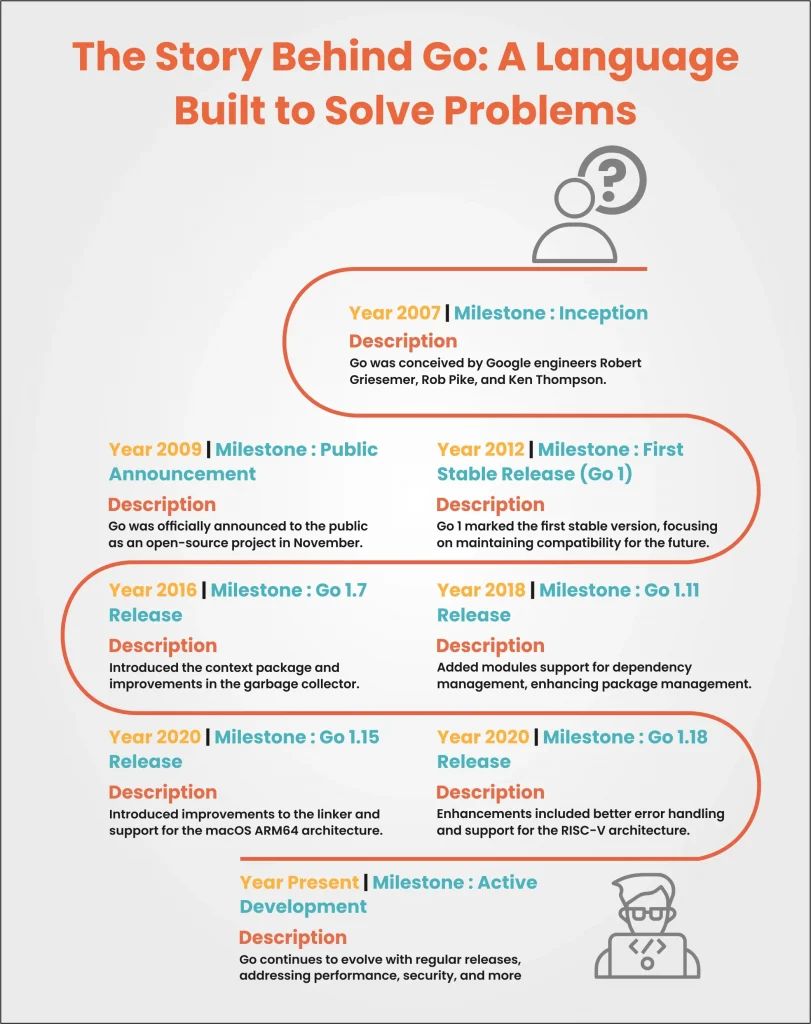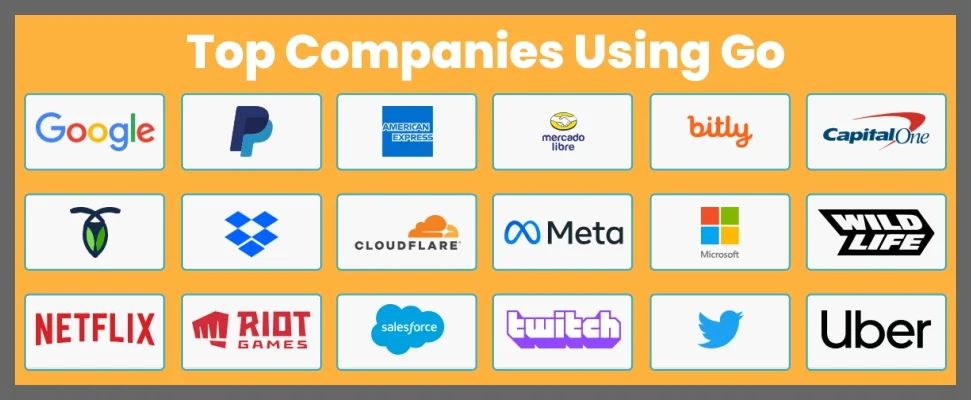Table of Contents
ToggleIntroduction - What is Golang?
New programming languages emerge regularly in the world of software and technology. Having said that, one such language that has gained considerable attention is Go. Go is often referred to as Golang.
Golang was developed by Google engineers Robert Griesemer, Rob Pike, and Ken Thompson. Golang or Go was designed to address the limitations of existing languages. Also, to offer a streamlined approach to building robust and efficient software.
| Aspect | Description |
|---|---|
| Purpose | Build simple, secure, scalable systems with Go |
| Supported by | Google (an open-source programming language) |
| Learning Curve | Easy to learn and great for teams |
| Key Features | Built-in concurrency and a robust standard library |
| Ecosystem | Large ecosystem of partners, communities, and tools |
The Story Behind Go: A Language Built to Solve Problems

How did Golang or Go come into existence?
Go came to life to tackle Google’s own software challenges. It all started when Google faced difficulties with their existing tools, like C++. Moreover, they saw a growing demand for a language that could handle the power of modern processors with multiple cores.
Around 2007, Google’s smart minds set out to create Go. Their goal? To make a language that was simpler than what was already out there. Also, without taking away the good parts from languages like C++, Python, and JavaScript. They wanted a language that was user-friendly and efficient.
Subsequently, in 2009, they shared Go with the world as an open-source project. This meant that anyone interested could join in, share ideas, and write code.
Again, in 2012, Go version 1.0 made its official debut.
As time rolled on, Go didn’t stand still. It kept improving and gaining new features. Finally, Go was introduced with a new feature called generics in 2022. This feature added enhanced Go’s versatility and capability. With every enhancement, the popularity of Go soared.
Tech giants such as Cloudflare, Google, MongoDB, Dropbox, Twitch,
Netflix, SoundCloud, Uber adopted Go for their development projects. .
So, Go was born out as a solution to some real problems. Google’s smart minds developed Go with an intent to offer a simple and efficient programming language to the developer community. Thus, Go is a language embraced by a community of developers and companies looking to build amazing things.
What is Go used for?
| Use Case | Key Attributes |
|---|---|
| Web Application Development | Scalability, Efficiency |
| System-level Programming | High Performance, Low-Level |
| Networking Applications | Concurrency, Network Services |
| Distributed Systems | Microservices, Concurrency |
| Container Ecosystem | Docker, Kubernetes Integration |
| Cloud Services | Efficiency, Serverless Support |
| Command-Line Tools | Simplicity, Performance |
| DevOps & Infrastructure | Automation, Management Tools |
Go is a programming language that software developers use to build different types of software:
- To Develop Network Services: Go is particularly suitable for building network services including web servers, APIs, and mini frameworks for web applications.
- Cloud-Native Development: Many cloud platforms such as Kubernetes and Google Cloud were developed on Go. Go’s concurrency and networking features makes it highly portable across various platforms.
- Replacing Old Infrastructure: Go was used to rewrite many old infrastructure. This was an attempt to modernize the obsolete infrastructure obsolete over time. For instance, a new version of the Network Time Protocol (NTP) – an internet protocol for clock synchronization among networks – depends heavily on Go.
- Building Small Tooling Items : Go can function on its own without any dependency on other languages or tool. So, it is well-suited for building small tooling items. These can launch quickly and be packaged for redistribution at a moment’s notice.
- News Portals: Media giant BBC uses Go for its backend development. It’s probably safe to assume Go’s capacity for multithreading to maximize CPU usage helps more often than not when it comes to managing a massive multimedia website.
What Are the Latest Advancements in Go Technology?
With the release of Go 2.0, Go technology has better support for error handling, generics, improved package management, and enhanced tooling. Let’s take a closer look at it down below:
Generics: It promotes flexibility and code reusability. Golang developers can use functions and data structures to work with different types. It also simplifies the process of creating libraries and data structures. With the release of generics, Go continues to become a more powerful and versatile language.
Enhanced error handling: Even though error handling in Golang is straightforward and effective, it can lead to lengthy expressions and repetitive code. Error handling was the hot topic of debate among Golang developers. But Go 2.0 has introduced improved error handling with error values and additional context that makes it extremely easy to spot issues.
Better Tools: The Golang ecosystem is known for its robust and straightforward tools. Better IDE, improved code analysis, and dependency management. This will not only streamline the development workflow but also boost productivity.
Focus on WebAssembly: WebAssembly allows developers to run Golang code directly in web browsers. Go’s small binary size and high performance make it best suited for WebAssembly development. In the upcoming years, we can see massive support and optimizations for Go programs in the browser. In the coming years, Golang developers can build games using Goang.
Expansion in Various Domains: The Golang ecosystem is continually growing. This opens up the possibilities of Golang in machine learning, web development, and cloud-native applications. This latest advancement in Go technology makes it an excellent choice for building a wide range of applications.
Top Companies Using Go

➜ American Express: They were able to accelerate and scale their payments and rewards network.
➜ Allegro: Allegro has developed a quick cache service with tons of entries, which, reduced their request times.
➜ Bitly: Bitly made use of Go for its simplicity and performance, It ported legacy services and new projects using Go.
➜ Dropbox: Dropbox moved its backends from Python to Go, which helped them in enhancing concurrency.
➜ Facebook: Facebook built an entity framework in Go.
➜ Cloudflare: Empowers core services, including DNS, SSL, and load testing, due to Go’s capabilities.
➜ Google: Google used it for various products and services due to its scalability.
Golang Job Opportunities
| Job | Roles |
|---|---|
| Web Developer | This role requires developers to build and maintain web services and APIs. Also, work along with frameworks like Echo, Beego, Gin, Revel, and Chi. |
| DevOps Engineer | Golang engineers need to work more on automation, CI/CD pipelines, and infrastructure as code. |
| Full stack Developers | Golang developers need to handle both frontend and backend aspects of software development. |
| Cloud Developer | Developers need to work on cloud platforms like AWS, Azure, or Google Cloud. |
| System Developer | This role requires the ability to build and maintain system-level software. |
| Technical Manager | This is a leadership role that requires them to manage teams, oversee projects, and make strategic decisions. |
Take control of your career and land your dream job
Sign up with us now and start applying for the best opportunities!

Final Thoughts
Go is a powerful language that offers a pragmatic approach to programming. Its simplicity, concurrency model, performance, and strong community support make it a solid choice for various applications. However, like any programming language, its suitability depends on the specific requirements of the project and the preferences of the development team.
Frequently Asked Questions
Yes, Go is used for backend programming. It has been utilized in projects such as Docker, where the Docker daemon – responsible for container management – is developed using Go.
Comparing programming languages is complex as their suitability varies across use cases. Golang exhibits advantages over Python in areas like microservices, APIs, and rapid-loading features.
Golang’s simplicity, strong concurrency model, and efficient compiled code often lead to faster development and execution compared to Java.
Yes, Go’s simplicity and readability make it a good choice for beginners to learn programming.
Interfaces in Golang let developers write generic code that can be used with any type. It also contributes to flexibility and scalability in software development.
Yes, Go has libraries like “fyne” and “walk” that allow to create graphical user interface applications.
Go is compiled; the source code is compiled into machine-readable binaries before execution.
Goroutines are lightweight concurrent execution units in Go that allow efficient handling of thousands of concurrent tasks.
Go is statically typed, meaning variable types are determined at compile time.
Yes, Go includes an automatic garbage collector that manages memory allocation and deallocation.
The Go compiler translates code into machine code. This process involves several stages, including lexical analysis, parsing, semantic analysis, optimization, and code generation.

